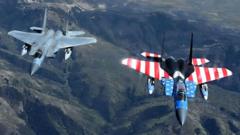More than 3,000 Boeing defence workers are poised to strike on Monday, signaling yet another challenge for the aviation colossus. This initiative follows a recent vote by union members in Missouri and Illinois—with the workers responsible for constructing F-15 fighter jets and other military aircraft—who rejected Boeing's latest proposal concerning pay, work schedules, and pensions.
Dan Gillian, vice president of Boeing's Air Dominance unit, expressed disappointment over the rejection of an offer that included 40% average wage growth. Boeing faces a complicated recovery after facing multiple issues, including safety concerns and a disruptive seven-week strike by passenger aircraft workers last year.
The impending strike is spearheaded by a local branch of the International Association of Machinists and Aerospace Workers (IAM) from St Louis, a pivotal site for Boeing's defence manufacturing. Union official Tom Boelling asserted, "Members have spoken loud and clear; they deserve a contract that reflects their skill, dedication, and the critical role they play in our nation's defence."
Should the strike proceed, it would mark the first labour action at Boeing's defence sector since 1996, which previously halted operations for over three months. IAM is a major union in the U.S., advocating for roughly 600,000 workers across aerospace, defence, shipbuilding, and manufacturing industries.
Boeing has been beleaguered by recent crises, including two catastrophic accidents and a severe mid-air incident involving one of their aircraft. Notably, a 2018 Boeing 737 crash in Indonesia resulted in 189 fatalities, while a separate incident in Ethiopia claimed 157 lives shortly after takeoff.
In 2024, a malfunction occurred when a panel covering an unused emergency exit of a Boeing 737 Max dislodged mid-flight. A previous strike by approximately 30,000 workers in the passenger jet division cost Boeing substantial financial losses, contributing to existing issues.
In the past year, the company reported a mere 348 aircraft deliveries—its lowest output since the pandemic—to further compound its troubles.



















